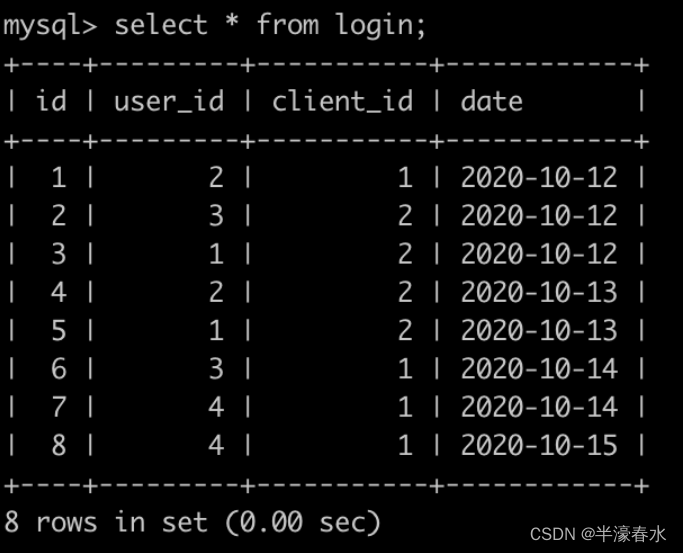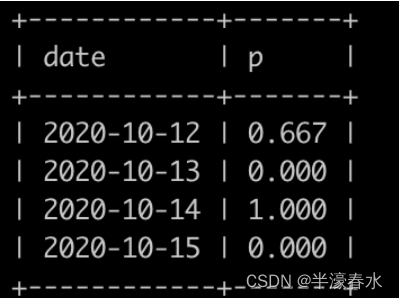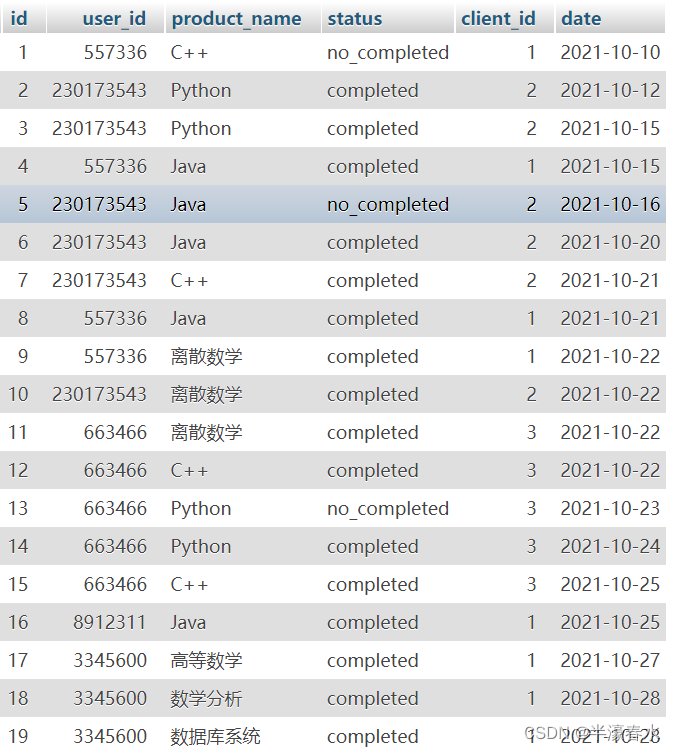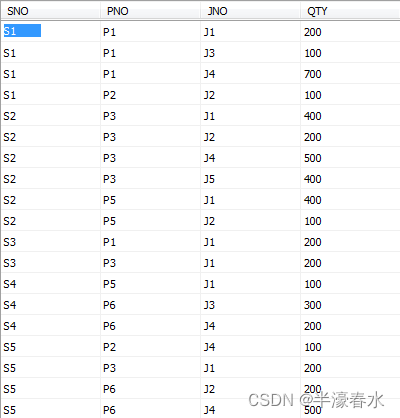The first level is to find the products with more than 20 purchases and less than 50 weights, and sort them in ascending order of product id
Task description
There is a product table (goods) as follows, the fields are: productid, product name, product quality
+------+------+--------+
| id | name | weight |
+------+------+--------+
| 1 | A1 | 100 |
| 2 | A2 | 20 |
| 3 | B3 | 29 |
| 4 | T1 | 60 |
| 5 | G2 | 33 |
| 6 | C0 | 55 |
+------+------+--------+
There is also a transaction table (
trans), the fields are: transactionid, productid, and the number of purchases of this product
+------+----------+-------+
|tran_id| id | count |
+------+----------+-------+
| 1 | 3 | 10 |
| 2 | 1 | 44 |
| 3 | 6 | 9 |
| 4 | 1 | 2 |
| 5 | 2 | 65 |
| 6 | 5 | 23 |
| 7 | 3 | 20 |
| 8 | 2 | 16 |
| 9 | 4 | 5 |
| 10 | 1 | 3 |
+------+----------+-------+
Find the products purchased more than and
20less than the weight50, and sort them inidascending order, such as:
+------+-------+
| id | total |
+------+-------+
| 2 | 81 |
| 3 | 30 |
| 5 | 23 |
+------+-------+
Example 1
input:
CREATE TABLE goods (
id int(11) NOT NULL,
name varchar(10) DEFAULT NULL,
weight int(11) NOT NULL,
PRIMARY KEY (id)
);
CREATE TABLE trans (
tran_id int(11) NOT NULL,
id int(11) NOT NULL,
count int(11) NOT NULL,
PRIMARY KEY (tran_id)
);
insert into goods values(1,'A1',100);
insert into goods values(2,'A2',20);
insert into goods values(3,'B3',29);
insert into goods values(4,'T1',60);
insert into goods values(5,'G2',33);
insert into goods values(6,'C0',55);
insert into trans values(1,3,10);
insert into trans values(2,1,44);
insert into trans values(3,6,9);
insert into trans values(4,1,2);
insert into trans values(5,2,65);
insert into trans values(6,5,23);
insert into trans values(7,3,20);
insert into trans values(8,2,16);
insert into trans values(9,4,5);
insert into trans values(10,1,3);
output:
id total
2 81
3 30
5 23
SELECT goods.id,sum(count) as total
FROM goods JOIN trans
WHERE goods.id=trans.id
AND weight<50
GROUP BY goods.id
HAVING total>20
ORDER BY goods.id
Level 2 query to recommend music to the user whose user_id = 1 in the follow table.
Task description
Assume that there are several simplified data tables in the music database:
the followingfollowtable, the first column is the person who followsid, the second column is the person who is followedid, and the primary key2of this column isid
+---------+-------------+
| user_id | follower_id |
+---------+-------------+
| 1 | 2 |
| 1 | 4 |
| 2 | 3 |
+---------+-------------+
The first row of this table represents the users
idwho1follow the user for the second row of the table represents the users who follow the user for the third rowidof the table represents the users who follow the user for the user2id1id4id2id3Personal favorite music
music_likestable, the first column is the userid, the second column is the favorite musicid, the composition of this2columnidis the primary key
+---------+----------+
| user_id | music_id |
+---------+----------+
| 1 | 17 |
| 2 | 18 |
| 2 | 19 |
| 3 | 20 |
| 4 | 17 |
+---------+----------+
The first row of this table represents the music that the user
idhas1likedmusic_idfor ... The fifth row of this table represents the music that the user has liked for17id4music_id17Music
musictable, the first column is musicid, the second column is musicname,idwhich is the primary key
+----+------------+
| id | music_name |
+----+------------+
| 17 | yueyawang |
| 18 | kong |
| 19 | MOM |
| 20 | Sold Out |
+----+------------+
Please write a
MYSQLqueryuser_id = 1to recommend music to the people you follow. Don't recommend music that the user already likes, and sort it inmusicascendingmusic_nameorder. The results you return should not contain duplicates The above query results are as follows:
+------------+
| music_name |
+------------+
| kong |
| MOM |
+------------+
Example 1
input:
CREATE TABLE follow (
user_id int(4) NOT NULL,
follower_id int(4) NOT NULL,
PRIMARY KEY (user_id,follower_id));
CREATE TABLE music_likes (
user_id int(4) NOT NULL,
music_id int(4) NOT NULL,
PRIMARY KEY (user_id,music_id));
CREATE TABLE music (
id int(4) NOT NULL,
music_name varchar(32) NOT NULL,
PRIMARY KEY (id));
INSERT INTO follow VALUES(1,2);
INSERT INTO follow VALUES(1,4);
INSERT INTO follow VALUES(2,3);
INSERT INTO music_likes VALUES(1,17);
INSERT INTO music_likes VALUES(2,18);
INSERT INTO music_likes VALUES(2,19);
INSERT INTO music_likes VALUES(3,20);
INSERT INTO music_likes VALUES(4,17);
INSERT INTO music VALUES(17,'yueyawang');
INSERT INTO music VALUES(18,'kong');
INSERT INTO music VALUES(19,'MOM');
INSERT INTO music VALUES(20,'Sold Out');
output:
music_name
kong
MOM
select distinct music_name
from follow f
right join music_likes ml
on f.follower_id=ml.user_id
right join music m
on ml.music_id=m.id
where f.user_id=1
AND music_name not in(
select music_name
from music_likes mls
right join music m1
on mls.music_id=m.id
where mls.user_id=1
)
order by music_name;
Level 3 queries to the user_id user in the follow table, and recommends the favorite music of the people he follows
Task description
Assume that there are several simplified data tables in the music database:
the followingfollowtable, the first column is the person who followsid, and the second column is the person who is followedid. These two columnsidform the primary key
+---------+-------------+
| user_id | follower_id |
+---------+-------------+
| 1 | 2 |
| 1 | 4 |
| 2 | 3 |
+---------+-------------+
The first row of this table represents the users
idwho1follow the user for the second row of the table represents the users who follow the user for the third rowidof the table represents the users who follow the user for the user2id1id4id2id3Personal favorite music
music_likestable, the first column is the userid, the second column is the favorite musicid, the composition of this2columnidis the primary key
+---------+----------+
| user_id | music_id |
+---------+----------+
| 1 | 17 |
| 2 | 18 |
| 2 | 19 |
| 3 | 20 |
| 4 | 17 |
+---------+----------+
The first row of this table represents the music that
iduser1likesmusic_idfor ... The fifth row of this table represents the music that user i likes for Music table, the first column is music i , the second column is music , is primary key17d4music_id17musicdnameid
+----+------------+
| id | music_name |
+----+------------+
| 17 | yueyawang |
| 18 | kong |
| 19 | MOM |
| 20 | Sold Out |
+----+------------+
Please write a
MYSQLquery to recommend the favorite music to the usersfollowin the table .user_idDon't recommend music that the user already likes, and sort it first in ascending order of and then infollowascending order of . The results you return should not contain duplicates The above query results are as follows:user_idmusicmusic_name
+------------+
| music_name |
+------------+
| kong |
| MOM |
+------------+
Example 1
input:
CREATE TABLE follow (
user_id int(4) NOT NULL,
follower_id int(4) NOT NULL,
PRIMARY KEY (user_id,follower_id));
CREATE TABLE music_likes (
user_id int(4) NOT NULL,
music_id int(4) NOT NULL,
PRIMARY KEY (user_id,music_id));
CREATE TABLE music (
id int(4) NOT NULL,
music_name varchar(32) NOT NULL,
PRIMARY KEY (id));
INSERT INTO follow VALUES(1,2);
INSERT INTO follow VALUES(1,4);
INSERT INTO follow VALUES(2,3);
INSERT INTO music_likes VALUES(1,17);
INSERT INTO music_likes VALUES(2,18);
INSERT INTO music_likes VALUES(2,19);
INSERT INTO music_likes VALUES(3,20);
INSERT INTO music_likes VALUES(4,17);
INSERT INTO music VALUES(17,'yueyawang');
INSERT INTO music VALUES(18,'kong');
INSERT INTO music VALUES(19,'MOM');
INSERT INTO music VALUES(20,'Sold Out');
output:
user_id music_name
1 kong
1 MOM
2 Sold Out
SELECT DISTINCT follow.user_id,music_name
FROM follow ,music_likes,music
WHERE follow.follower_id=music_likes.user_id
AND music.id=music_likes.music_id
AND music_id NOT IN(
SELECT music_id
FROM music_likes m
WHERE m.user_id=follow.user_id
)
ORDER BY user_id,music_name;
Level 4 Query the user's DAU and payment amount
Task description
There are currently 3 business tables, see the following for details:
The required output results are as follows, and the date that has not been paid does not need to be displayed. Please write the corresponding MYSQL
example 1
input:
CREATE TABLE new_user(
user_id int(11) NOT NULL,
is_new int(11) NOT NULL,
PRIMARY KEY (user_id)
);
CREATE TABLE user_pay(
user_id int(11) NOT NULL,
pay_money int(11) NOT NULL,
dt char(20) NOT NULL
);
CREATE TABLE login_record(
user_id int(11) NOT NULL,
login_time char(20) NOT NULL,
dt char(20) NOT NULL
);
insert into new_user values(1,0);
insert into new_user values(2,1);
insert into new_user values(3,1);
insert into new_user values(4,0);
insert into new_user values(5,0);
insert into new_user values(6,1);
insert into new_user values(7,0);
insert into new_user values(8,1);
insert into user_pay values(1,30,'2021-11-10');
insert into user_pay values(1,100,'2021-11-10');
insert into user_pay values(2,500,'2021-11-11');
insert into user_pay values(2,200,'2021-11-12');
insert into user_pay values(3,1000,'2021-11-10');
insert into user_pay values(4,800,'2021-11-12');
insert into user_pay values(6,1200,'2021-11-10');
insert into user_pay values(6,700,'2021-11-14');
insert into login_record values(1,'8:00','2021-11-10');
insert into login_record values(1,'12:00','2021-11-10');
insert into login_record values(1,'13:00','2021-11-10');
insert into login_record values(2,'16:00','2021-11-10');
insert into login_record values(2,'12:35','2021-11-11');
insert into login_record values(2,'18:34','2021-11-12');
insert into login_record values(3,'20:00','2021-11-10');
insert into login_record values(4,'21:00','2021-11-12');
insert into login_record values(5,'21:00','2021-11-13');
insert into login_record values(6,'22:30','2021-11-10');
insert into login_record values(6,'13:30','2021-11-14');
output:
dt dau dau_new total_pay total_pay_new
2021-11-10 4 3 2330 2200
2021-11-11 1 1 500 500
2021-11-12 2 1 1000 200
2021-11-14 1 1 700 700
SELECT ftemp1.dt AS dt,dau,dau_new,total_pay,total_pay_new
FROM(SELECT temp1.dt,dau,dau_new
FROM(SELECT tempt2.dt,COUNT(is_new) AS dau_new
FROM (SELECT DISTINCT user_id,dt FROM login_record)
AS tempt2,new_user
WHERE new_user.user_id=tempt2.user_id
GROUP BY tempt2.dt,is_new
HAVING is_new=1) AS temp1,(SELECT tempt2.dt,COUNT(is_new) AS dau
FROM (SELECT DISTINCT user_id,dt FROM login_record) AS tempt2,new_user
WHERE new_user.user_id=tempt2.user_id
GROUP BY tempt2.dt)AS temp2
WHERE temp1.dt=temp2.dt) AS ftemp1,(SELECT temp3.dt,total_pay,total_pay_new
FROM (SELECT dt,SUM(pay_money) AS total_pay
FROM user_pay
GROUP BY dt)AS temp3,(SELECT user_pay.dt,SUM(pay_money) AS total_pay_new
FROM user_pay,new_user
WHERE user_pay.user_id=new_user.user_id
GROUP BY dt,is_new
HAVING is_new=1) AS temp4
WHERE temp3.dt=temp4.dt) AS ftemp2 WHERE ftemp1.dt=ftemp2.dt
Level 5 Query the next-day retention rate of new users of a website on each date
Task description
Task for this level: Query the next-day retention rate of new users of a website on each date.Related Knowledge
A lot of people log in to a website every day. Please count the next-day retention rate of new users on each date of the website.
There is a login (login) record table, the profile is as follows:
The user
1representeduser_idby row 1 has logged in to the website using the device where the client is. Since it is the first time to log in, it is a new user. The user represented by row 1 has logged in to the website using the client device as . Since it is the first time to log in, he is an old user. The last line indicates that the user logged in to the website using the device of the client is an old user because it is the first time to log in. Please write a statement to query the next-day retention rate of new users on each date. The result retains the number of digits after the decimal point ( rounded after the digit), and the query results are sorted in ascending order of date. The query results of the above example are as follows:22020-10-12id114user_id22020-10-13id221user_id42020-10-15id12sql33
The query results show that: there are ( for , , ) new users
2020-10-12logged in , and only ( for , ) are logged in, so the retention rate of new users the next day is ;3user_id2312020-10-132id212020-10-122/3=0.667
2020-10-13No new user is logged in, output0.000;
2020-10-14Logged in1(user_idfor4) new users,2020-10-15,user_idfor4users logged in, so2020-10-14the retention rate of new users the next day1/1=1.000;
2020-10-15No new user logged in, output0.000;Note:
1. The new user in this question is not a real new user definition, but a new user definition given in this question;
2. The functionMYSQLto calculate the difference between datest2and dates is: ; 3. The function to round a reserved bit for a field is: ; 4. The function to set the empty value of a certain field is: .t1datediff(t2,t1)MYSQLtotal3round(total,3)MYSQLtotal0ifnull(total,0)Example 1
input:
drop table if exists login;
CREATE TABLE login (
id int(4) NOT NULL,
user_id int(4) NOT NULL,
client_id int(4) NOT NULL,
date date NOT NULL,
PRIMARY KEY (id));
INSERT INTO login VALUES
(1,2,1,'2020-10-12'),
(2,3,2,'2020-10-12'),
(3,1,2,'2020-10-12'),
(4,2,2,'2020-10-13'),
(5,1,2,'2020-10-13'),
(6,3,1,'2020-10-14'),
(7,4,1,'2020-10-14'),
(8,4,1,'2020-10-15');
output:
date p
2020-10-12 0.667
2020-10-13 0.000
2020-10-14 1.000
2020-10-15 0.000
SELECT first1.date,ROUND (COUNT(second2.user_id)/COUNT(first1.user_id),3)AS p
FROM(
SELECT user_id, MIN(date) AS date
FROM login
GROUP BY user_id)first1
LEFT JOIN login second2 ON first1.user_id=second2.user_id
AND second2.date=date_add(first1.date,INTERVAL+1 DAY)
GROUP BY first1.date
UNION
SELECT date,0 AS p
FROM login
WHERE date NOT IN(
SELECT MIN(date)
FROM login
GROUP BY user_id)
ORDER BY date;
Level 6 Query users who meet the conditions
Task Description
Some students will purchase online training courses to learn. An educational website will generate an order for the purchase record and save it to the database. There is an order information table (order_info), the content of which is as follows:
The first
1row indicatesuser_idthat557336the user2021-10-10who is usingclient_idthe client of 1 placesC++an order for a course, but the status is that the purchase is not successful. The first2row is successfully purchased.Query the users who meet the following conditions:
in2021-10-15the future, if there is a2single and more than one course or courses or courses2with a status of successful purchase , then output the user's and the date of the first successful purchase that meets the condition , And the date of the second successful purchase that meets the previous conditions , as well as the number of successful purchases , and the output results are sorted in ascending order.C++JavaPythonuser_idfirst_buy_datesecond_buy_datecntuser_idFunction prompt
1.row_number() over(partition by某字段 order by 某字段): The window function is grouped by a certain field, and1the sequence number from the beginning is generated.
2.count(*) over(partition by 某字段): Find the total after grouping.Example 1
input:
drop table if exists order_info;
CREATE TABLE order_info(
id int(4) NOT NULL,
user_id int(4) NOT NULL,
product_name char(20) NOT NULL,
status char(20) NOT NULL,
client_id int(4) NOT NULL,
date date NOT NULL,
PRIMARY KEY (id));
INSERT INTO order_info VALUES
(1,557336,'C++','no_completed',1,'2021-10-10'),
(2,230173543,'Python','completed',2,'2021-10-12'),
(3,230173543,'Python','completed',2,'2021-10-15'),
(4,557336,'Java','completed',1,'2021-10-15'),
(5,230173543,'Java','no_completed',2,'2021-10-16'),
(6,230173543,'Java','completed',2,'2021-10-20'),
(7,230173543,'C++','completed',2,'2021-10-21'),
(8,557336,'Java','completed',1,'2021-10-21'),
(9,557336,'离散数学','completed',1,'2021-10-22'),
(10,230173543,'离散数学','completed',2,'2021-10-22'),
(11,663466,'离散数学','completed',3,'2021-10-22'),
(12,663466,'C++','completed',3,'2021-10-22'),
(13,663466,'Python','no_completed',3,'2021-10-23'),
(14,663466,'Python','completed',3,'2021-10-24'),
(15,663466,'C++','completed',3,'2021-10-25'),
(16,8912311,'Java','completed',1,'2021-10-25'),
(17,3345600,'高等数学','completed',1,'2021-10-27'),
(18,3345600,'数学分析','completed',1,'2021-10-28'),
(19,3345600,'数据库系统','completed',1,'2021-10-28');
output:
user_id first_buy_date second_buy_date cnt
663466 2021-10-22 2021-10-24 3
230173543 2021-10-20 2021-10-21 2
SELECT user_id,
MIN(CASE WHEN num=1 THEN date END) AS first_buy_date,
MAX(CASE WHEN num=2 THEN date END) AS second_buy_date,
COUNT(1) AS cnt
FROM(
SELECT*,row_number()over(PARTITION BY user_id ORDER BY date) AS num
FROM order_info
WHERE status='completed'
AND date >'2021-10-15'
AND product_name IN('C++','Java','Python'))TABLE2
GROUP BY user_id
HAVING COUNT(1)>=2;
Level 7 queries the largest total supply of each project number by part number and the part number, and first sorts in ascending order of project number, and then sorts in ascending order of part number.
Task description
Query the largest total supply of each project number by part number and the part number, and sort by the ascending order of the project number first, and then by the ascending order of the part number.Relevant knowledge
The supply situation table is composedSPJof supplier code (SNO), part code (PNO), project code (JNO), and supply quantity (QTY), which identifies the quantity that a certain supplier
supplies a certain part to a certain projectQTY.
SPJThe table is as follows:
The table has been built
SPJ, and the structure information is as follows:
CREATE VIEW nextdata(JNO,PNO,maxsum)
AS
SELECT JNO,PNO,SUM(QTY)
FROM SPJ
GROUP BY JNO,PNO
ORDER BY JNO,PNO;
SELECT JNO,PNO,maxsum
FROM nextdata AS S1
WHERE S1.maxsum >= ALL(
SELECT maxsum
FROM nextdata AS S2
WHERE S1.JNO = S2.JNO);






